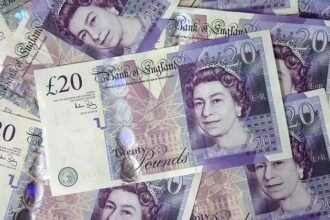- GBP/USD stays below 1.3100 following Tuesday’s meager recovery attempt.
- The bearish stance remains unchanged in the near term.
- The minutes of the FOMC’s September meeting will be scrutinized by investors.
GBP/USD managed to post small gains on Tuesday but failed to reclaim 1.3100. The pair stays relatively quiet in the European session on Wednesday as investors wait for the Federal Reserve (Fed) to publish the minutes of the September policy meeting.
British Pound PRICE This week
The table below shows the percentage change of British Pound (GBP) against listed major currencies this week. British Pound was the weakest against the Japanese Yen.
| USD | EUR | GBP | JPY | CAD | AUD | NZD | CHF | |
|---|---|---|---|---|---|---|---|---|
| USD | 0.04% | 0.19% | -0.09% | 0.73% | 0.86% | 1.28% | -0.18% | |
| EUR | -0.04% | 0.22% | -0.11% | 0.72% | 0.80% | 1.24% | -0.25% | |
| GBP | -0.19% | -0.22% | -0.37% | 0.51% | 0.58% | 1.05% | -0.36% | |
| JPY | 0.09% | 0.11% | 0.37% | 0.81% | 0.93% | 1.32% | -0.06% | |
| CAD | -0.73% | -0.72% | -0.51% | -0.81% | 0.15% | 0.54% | -0.91% | |
| AUD | -0.86% | -0.80% | -0.58% | -0.93% | -0.15% | 0.48% | -0.98% | |
| NZD | -1.28% | -1.24% | -1.05% | -1.32% | -0.54% | -0.48% | -1.42% | |
| CHF | 0.18% | 0.25% | 0.36% | 0.06% | 0.91% | 0.98% | 1.42% |
The heat map shows percentage changes of major currencies against each other. The base currency is picked from the left column, while the quote currency is picked from the top row. For example, if you pick the British Pound from the left column and move along the horizontal line to the US Dollar, the percentage change displayed in the box will represent GBP (base)/USD (quote).
The recovery seen in Wall Street’s main indexes made it difficult for the US Dollar (USD) to gather strength during the American trading hours on Tuesday, allowing GBP/USD to cling to modest daily gains.
Early Wednesday, the souring market mood, after a nearly 7% decline recorded in China’s Shanghai Composite Index, caps GBP/USD’s upside.
The Fed cut the policy rate by 50 basis points (bps) after the September meeting. Investors will scrutinize the FOMC Minutes to see whether policymakers are willing to consider more large rate cuts in the near future.
If the publication shows that officials don’t think that they will need to continue to ease the policy aggressively moving forward, the immediate market reaction could support the USD. Nevertheless, the CME FedWatch Tool shows that markets already price in a nearly 90% probability of the Fed opting for a smaller, 25 bps, rate reduction at the November meeting. Hence, the positive impact of a hawkish FOMC Minutes on the USD could remain short-lived.
GBP/USD Technical Analysis
The Relative Strength Index (RSI) remains in the bearish territory, well below 50, while staying above 30, suggesting that GBP/USD could stretch lower before staging a technical correction.
Immediate support aligns at 1.3050 (static level) before 1.3000 (round level, static level) and 1.2940 (static level). In case GBP/USD manages to clear 1.3100 (Fibonacci 78.6% retracement level of the latest uptrend), it could extend its recovery toward 1.3170 (Fibonacci 61.8% retracement).
Pound Sterling FAQs
The Pound Sterling (GBP) is the oldest currency in the world (886 AD) and the official currency of the United Kingdom. It is the fourth most traded unit for foreign exchange (FX) in the world, accounting for 12% of all transactions, averaging $630 billion a day, according to 2022 data. Its key trading pairs are GBP/USD, also known as ‘Cable’, which accounts for 11% of FX, GBP/JPY, or the ‘Dragon’ as it is known by traders (3%), and EUR/GBP (2%). The Pound Sterling is issued by the Bank of England (BoE).
The single most important factor influencing the value of the Pound Sterling is monetary policy decided by the Bank of England. The BoE bases its decisions on whether it has achieved its primary goal of “price stability” – a steady inflation rate of around 2%. Its primary tool for achieving this is the adjustment of interest rates. When inflation is too high, the BoE will try to rein it in by raising interest rates, making it more expensive for people and businesses to access credit. This is generally positive for GBP, as higher interest rates make the UK a more attractive place for global investors to park their money. When inflation falls too low it is a sign economic growth is slowing. In this scenario, the BoE will consider lowering interest rates to cheapen credit so businesses will borrow more to invest in growth-generating projects.
Data releases gauge the health of the economy and can impact the value of the Pound Sterling. Indicators such as GDP, Manufacturing and Services PMIs, and employment can all influence the direction of the GBP. A strong economy is good for Sterling. Not only does it attract more foreign investment but it may encourage the BoE to put up interest rates, which will directly strengthen GBP. Otherwise, if economic data is weak, the Pound Sterling is likely to fall.
Another significant data release for the Pound Sterling is the Trade Balance. This indicator measures the difference between what a country earns from its exports and what it spends on imports over a given period. If a country produces highly sought-after exports, its currency will benefit purely from the extra demand created from foreign buyers seeking to purchase these goods. Therefore, a positive net Trade Balance strengthens a currency and vice versa for a negative balance.






















